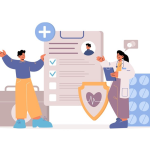
Role of Staff and Doctor Surveys In Improving Hospital Performance
Surveys of hospital staff and doctors are essential for enhancing hospital performance. Their feedback offers critical insights into hospital operations, patient care, and workplace satisfaction, helping to drive continuous improvement.
Why Staff and Doctor Surveys Matter
Staff and doctor surveys provide a direct line of communication between hospital management and the medical professionals on the front lines. These surveys allow healthcare workers to share their experiences, concerns, and suggestions in a structured manner.
The feedback gathered can be used to address issues that might otherwise go unnoticed, improving both employee satisfaction and patient outcomes.
Improving Patient Care Through Feedback
Patient care is the cornerstone of hospital performance. When staff and doctor surveys reveal issues with procedures, equipment, or policies, hospital management can take targeted actions to resolve them.
For instance, if surveys indicate that certain medical protocols are outdated or inefficient, hospitals can revise these practices to improve patient safety and care quality.
Patient safety is often highlighted in these surveys. Identifying trends in survey responses can uncover systemic issues, such as understaffing or equipment shortages, which may compromise patient care.
By addressing these concerns, hospitals can enhance the overall quality of their services, leading to better patient outcomes.
Enhancing Staff Morale and Retention
Staff and doctor surveys also play a crucial role in enhancing staff morale. Healthcare professionals work in high-stress environments, and their job satisfaction directly affects their performance.
Surveys can uncover factors contributing to low morale, such as long working hours, insufficient resources, or a lack of professional development opportunities.
When hospitals act on survey results to improve working conditions, they demonstrate a commitment to their employees’ well-being. This can lead to higher job satisfaction, reduced turnover rates, and a more motivated workforce.
Additionally, a hospital that values its staff’s opinions is likely to attract top talent, further enhancing its performance.
Identifying Training and Development Needs
Staff and doctor surveys are an effective tool for identifying training and development needs within a hospital. By asking specific questions about skills and knowledge gaps, hospitals can pinpoint areas where additional training is required.
This ensures that all staff members are equipped with the latest knowledge and techniques, which is essential in a field as rapidly evolving as healthcare.
For example, if survey responses indicate a lack of confidence among staff in using new medical technologies, the hospital can organize targeted training sessions. By addressing these gaps, hospitals not only improve the competence of their staff but also the quality of care provided to patients.
Promoting a Culture of Continuous Improvement
One of the most significant benefits of staff and doctor surveys is their role in promoting a culture of continuous improvement within hospitals.
When hospitals regularly conduct surveys and act on the feedback received, it sends a clear message that they are committed to ongoing development and excellence.
This culture of improvement encourages staff to take an active role in identifying areas for enhancement. It fosters an environment where feedback is valued and used constructively, leading to sustained improvements in hospital performance over time.
Addressing Communication Barriers
Effective communication is critical in any healthcare setting, and staff and doctor surveys can help identify communication barriers within hospitals. Whether it’s between different departments, shifts, or levels of staff.
Poor communication can lead to misunderstandings, mistakes, and ultimately, compromised patient care. Survey responses can highlight areas where communication is breaking down, allowing hospital management to implement strategies to improve it.
This might include revising protocols for handovers between shifts, improving inter-departmental communication channels, or providing training in effective communication skills.
Boosting Patient Satisfaction
Patient satisfaction is a key indicator of hospital performance, and staff and doctor surveys can have a direct impact on this metric. When staff members feel supported and valued, they are more likely to provide high-quality, compassionate care, which in turn boosts patient satisfaction.
Moreover, surveys can help identify specific patient concerns from the perspective of those who interact with them daily. By addressing these issues, hospitals can enhance the patient experience, leading to higher satisfaction scores and a better reputation.
Using Data to Drive Decision-Making
The data collected from staff and doctor surveys is invaluable for hospital management. It provides a quantitative basis for decision-making, allowing hospitals to prioritize initiatives that will have the most significant impact on performance.
For instance, if survey data reveals widespread dissatisfaction with a particular administrative process, the hospital can focus on streamlining or overhauling that process. This data-driven approach ensures that resources are allocated efficiently and that improvements are targeted where they are most needed.
Implementing Actionable Changes
The true value of staff and doctor surveys lies in the actionable insights they provide. However, for surveys to be effective, hospitals must be committed to implementing changes based on the feedback received.
This requires a structured approach to analyzing survey results, identifying key areas for improvement, and developing action plans to address them. Regular follow-up is also essential.
Hospitals should track the impact of the changes made and continue to gather feedback to ensure that the improvements are effective. This ongoing cycle of feedback and improvement is key to driving sustained enhancements in hospital performance.
Overcoming Resistance to Change
While staff and doctor surveys are a powerful tool for improvement, they can also reveal resistance to change within a hospital. Some staff members may be hesitant to adopt new practices or technologies, particularly if they have been working in the same way for many years.
By using survey data to understand the root causes of this resistance, hospitals can develop strategies to overcome it. This might involve providing additional training, offering incentives for embracing change or involving staff more directly in the decision-making process.
Addressing resistance proactively ensures that improvements can be implemented smoothly and effectively.
Enhancing Operational Efficiency
Staff and doctor surveys can also uncover inefficiencies in hospital operations. For example, surveys might reveal that certain administrative processes are unnecessarily time-consuming or that staff members are spending too much time on non-patient-related tasks.
By identifying these inefficiencies, hospitals can take steps to streamline their operations, freeing up more time for staff to focus on patient care. This not only improves the quality of care provided but also enhances overall hospital performance by making better use of resources.
Creating a Supportive Work Environment
A supportive work environment is essential for both staff well-being and hospital performance. Staff and doctor surveys can help identify areas where the work environment could be improved, whether it’s through better facilities, more flexible working hours, or additional support services.
When hospitals take steps to create a more supportive work environment, they can expect to see improvements in staff morale, productivity, and retention.
A positive work environment also contributes to better patient care, as staff members who feel supported are more likely to be engaged and motivated in their work.
Fostering Collaboration and Teamwork
Collaboration and teamwork are critical components of hospital performance, and staff and doctor surveys can help foster these qualities. Surveys can reveal areas where teamwork is strong and where it needs improvement, providing valuable insights into how teams function within the hospital.
For instance, if surveys indicate that certain departments struggle with collaboration, the hospital can implement initiatives to improve inter-departmental teamwork. This might include team-building exercises, cross-training programs, or better communication tools.
By fostering a collaborative work environment, hospitals can enhance both staff satisfaction and patient care.
Measuring the Impact of Initiatives
Hospitals often implement various initiatives to improve performance, but it can be challenging to measure their impact. Staff and doctor surveys provide a valuable tool for assessing the effectiveness of these initiatives.
By comparing survey responses before and after the implementation of a new initiative, hospitals can gauge whether it has had the desired effect.
For example, if a hospital introduces a new patient safety protocol, surveys can help determine whether staff members feel more confident in their ability to keep patients safe. This feedback is crucial for refining and improving initiatives over time.
Aligning Hospital Goals with Staff Priorities
For a hospital to perform at its best, its goals must align with the priorities of its staff. Staff and doctor surveys offer a way to ensure that this alignment is in place. By understanding what is most important to their employees, hospitals can tailor their goals and strategies to better meet these priorities.
For instance, if surveys indicate that staff members are particularly concerned about work-life balance, the hospital might prioritize initiatives that address this issue. This alignment between hospital goals and staff priorities leads to greater engagement, satisfaction, and ultimately, better performance.
Encouraging Innovation and Creativity
Innovation is essential in healthcare, and staff and doctor surveys can encourage creativity among hospital staff. By providing a platform for employees to share their ideas and suggestions, surveys can inspire new ways of thinking about common challenges.
For example, a staff member might suggest a novel approach to reducing patient wait times, which could be implemented hospital-wide if proven effective. Encouraging this kind of innovation not only improves hospital performance but also keeps staff engaged and invested in their work.
Building Trust Between Staff and Management
Trust between staff and management is crucial for a high-performing hospital. Staff and doctor surveys can help build this trust by demonstrating that management values employee input and is willing to act on it.
When staff members see that their feedback leads to real changes, they are more likely to trust management and feel confident that their concerns will be addressed. This trust is essential for fostering a positive work environment and ensuring that everyone is working toward the same goals.
Leveraging Technology for Better Surveys
Technology plays a significant role in the effectiveness of staff and doctor surveys. Online survey tools make it easier for hospitals to collect, analyze, and act on feedback in real-time. These tools also allow for greater customization, enabling hospitals to tailor surveys to their specific needs and objectives.
Additionally, technology can help ensure that surveys are accessible to all staff members, regardless of their role or location within the hospital. This inclusivity is essential for gathering comprehensive feedback and ensuring that all voices are heard.
Addressing Burnout Among Healthcare Workers
Burnout is a significant issue in healthcare, and staff and doctor surveys can help hospitals address it. Surveys can identify early signs of burnout, such as high levels of stress, fatigue, or job dissatisfaction, allowing hospitals to take proactive measures to support their staff.
By addressing burnout early, hospitals can prevent it from affecting staff performance and patient care. This might involve offering mental health support, reducing workloads, or promoting work-life balance. Preventing burnout is essential for maintaining a healthy, productive workforce.
Encouraging Diversity and Inclusion
Diversity and inclusion are increasingly recognized as essential components of hospital performance. Staff and doctor surveys can help hospitals assess their progress in these areas and identify any barriers to creating a more inclusive work environment.
For example, surveys might reveal that certain groups of employees feel underrepresented or that there are gaps in cultural competence training. By addressing these issues, hospitals can create a more inclusive environment that benefits both staff and patients.
Improving Work-Life Balance
Work-life balance is a critical factor in staff satisfaction and retention. Staff and doctor surveys can highlight areas where work-life balance is lacking and suggest ways to improve it. This might include offering more flexible working hours, providing childcare support, or encouraging the use of vacation time.
By promoting a better work-life balance, hospitals can reduce stress and burnout among their staff, leading to higher morale and better overall performance.
Adapting to Changes in the Healthcare Landscape
The healthcare landscape is constantly evolving, and hospitals must adapt to stay competitive. Staff and doctor surveys provide valuable insights into how well a hospital is adapting to changes, whether it’s new technologies, regulations, or patient care practices.
By regularly conducting surveys, hospitals can stay ahead of the curve and ensure that they are continuously improving in line with industry standards and expectations. This adaptability is key to maintaining high performance in a rapidly changing environment.
Empowering Staff to Take Ownership
Empowering staff to take ownership of their roles is essential for a high-performing hospital. Staff and doctor surveys can help identify areas where employees feel disempowered and suggest ways to give them more control over their work.
For example, surveys might reveal that staff members feel they lack the autonomy to make decisions about patient care. By addressing this issue, hospitals can empower their staff to take greater ownership of their work, leading to increased job satisfaction and better patient outcomes.
Conclusion
Staff and doctor surveys are an indispensable tool for improving hospital performance. By providing valuable insights into patient care, staff satisfaction, and operational efficiency, these surveys help hospitals identify areas for improvement and implement targeted changes.
When hospitals listen to their staff and act on their feedback, they can foster a culture of continuous improvement that benefits everyone—staff, patients, and the hospital as a whole.
Frequently Asked Questions (FAQs)
How Do Staff And Doctor Surveys Improve Patient Care?
Staff and doctor surveys identify issues in hospital procedures, equipment, or policies, allowing management to make targeted improvements that enhance patient care and safety.
What Role Do Surveys Play In Enhancing Staff Morale?
Surveys reveal factors that affect staff morale, such as working conditions or resource availability. By addressing these issues, hospitals can improve job satisfaction and reduce turnover.
How Can Hospitals Use Survey Data To Drive Decision-Making?
Survey data provides a quantitative basis for decision-making, helping hospitals prioritize initiatives that will have the most significant impact on performance.
What Are The Benefits of A Culture of Continuous Improvement?
A culture of continuous improvement encourages staff to actively participate in identifying and addressing areas for enhancement, leading to sustained improvements in hospital performance.
How Can Surveys Help Address Communication Barriers In Hospitals?
Surveys can uncover communication issues within a hospital, allowing management to implement strategies to improve information flow between departments and staff levels.
Why Is Trust Between Staff And Management Important?
Trust between staff and management is crucial for a positive work environment. Surveys help build this trust by showing that management values and acts on employee feedback.
Enhance Patient Care and NABH Compliance with LazyMonkey
LazyMonkey is your all-in-one solution for improving patient care, retaining more patients, and meeting NABH standards. Our powerful QR-based feedback tool enables you to capture real-time insights from patient feedback, discharge surveys, staff and doctor evaluations, and clinical research, while also streamlining inter-departmental communication.
Transform your healthcare facility today - reach out to us at [email protected], or request a demo here!
Elevate Your Restaurant Experience with LazyMonkey
LazyMonkey’s QR-based feedback system helps you gather real-time insights from customers, track satisfaction levels, and enhance the dining experience. Get instant feedback on your menu, service, and ambience, and make data-driven improvements to boost repeat customers and reviews.
Improve your restaurant today – reach out to us at [email protected], or request a demo here!
Empower Student Engagement and Campus Improvement with LazyMonkey
LazyMonkey offers a seamless way to gather student feedback, track satisfaction, and enhance campus life. From course evaluations to dorm feedback, our QR-based solution makes it easy to capture valuable insights and improve student retention.
Upgrade your university experience – contact us at [email protected], or request a demo here!
Streamline Feedback and Drive Performance Across Your Enterprise/Franchise with LazyMonkey
Whether you manage one or multiple locations, LazyMonkey’s QR-based feedback system helps you gather real-time employee and customer feedback. Improve operational efficiency, track satisfaction, and make data-driven decisions to enhance brand consistency and growth.
Transform your franchise today – reach out to us at [email protected], or request a demo here!
Enhance Customer Satisfaction and Service Standards in Banking with LazyMonkey
LazyMonkey empowers banks to capture real-time feedback from clients across branches. Improve customer experience, assess service quality, and ensure regulatory compliance with our QR-based solution, helping you retain clients and meet banking standards.
Elevate your bank’s customer care – contact us at [email protected], or request a demo here!
Boost Customer Engagement and Mall Satisfaction with LazyMonkey
LazyMonkey’s QR-based feedback tool enables you to collect feedback from shoppers, track satisfaction, and enhance the mall experience. Gather insights on store services, cleanliness, and entertainment to create an unmatched customer journey.














